Upper Foreshore Evolution and Sea Wall Stability, Jersey, Channel Islands
Keywords:
Macro-tidal, beach morphology, sediment dynamics, nearshore environment, seawallAbstract
The west coast of Jersey is a high energy, macro-tidal environment, which experiences contrasting beach morphology between storm and non-storm conditions, giving rise to an apparent seasonal differentiation between 'summer' and 'winter' beach states, as recorded in numerous previous studies (SHEPARD and LAFOND, 1940; DUBOIS, 1988). In the summer, long periods (measured in weeks) of low wave energy levels give rise to a series of low amplitude (0.5 m) ridges occurring across the inter-tidal zone, with scouring apparent at the base of the wall. The initial onset of storm conditions, produces a rapid change in morphology, occurring in a matter of days, with ridges planed down and coarse material, in the pebble and shingle size fraction, transported landwards, to form a steep, protective beach at the wall's base. The return to summer morphology is a much slower process, occurring over a matter of months and frequently being disturbed by further increases in energy levels. Although environmental conditions would indicate that the winter storm period was most vulnerable to sea wall failure, the beach response actually results in greatest stability at this time.
Correlation analysis revealed that the factors most closely related to beach evolution in the inter-tidal zone were wave height, wind speed and wind direction. Steepness, although widely reported as being a significant variable inducing beach change (SALLENGER et al., 1985), appears to be largely unrelated to morphological evolution at this site. In the vicinity of the wall, in contrast to the remainder of the beach, the height of High Water (HW) was shown to become the predominant control on beach levels. Although large waves were responsible for the initial onshore transport of the pebble fraction at the start of the storm period, the subsequent impact of this variable was secondary to tidal influence.
A different beach response to the tidal cycle was observed between the winter and summer beach morphology. In the summer, when sand levels were low, the move towards spring tides encouraged erosion. However, high levels observed during the winter season, were associated with accretion on the move from neap to spring tides.


